Abstract
A dual signal-amplified sandwich electrochemiluminescence (ECL) immunosensor was fabricated for trace detection of procalcitonin (PCT). CeO2-Au@Pt composed of sea urchin-like Au@Pt nanoparticles coated on CeO2 hollow nanospheres was immobilized on electrode surface to electrochemically catalyze H2O2 to produce a large number of superoxide anion (O2•−). The immunosensor was prepared by linking the capture antibody on immobilized CeO2-Au@Pt with heptapeptide (HWRGWVC), which could maintain the activity of the antibody. The prepared Au star@BSA was used to bind abundant luminol for labeling the secondary antibody (Ab2). Upon the sandwich-typed immunoreactions, the O2•− could react with the introduced luminol on the immunosensor surface to produce strong ECL intensity. With an outstanding linear detection range and a low detection limit of 17 fg/mL, the ECL immunosensor permitted ultrasensitive detection of PCT at a low H2O2 concentration and demonstrated its high application potential in the clinical assay.
Graphical abstract





Similar content being viewed by others
References
Dandona P, Nix D, Wilson MF, Aljada A, Love J, Assicot M, Bohuon C (1994) Procalcitonin increase after endotoxin injection in normal subjects. J Clin Endocrinol Metab 79:1605–1608. https://doi.org/10.1210/jcem.79.6.7989463
Li YK, Liu W, Jin G, Niu Y, Yiping Chen YP, Xie MX (2018) Label-free sandwich imaging ellipsometry immunosensor for serological detection of procalcitonin. Anal Chem 90:8002–8010. https://doi.org/10.1021/acs.analchem.8b00888
Buchegger P, Preininger C (2014) Four assay designs and on-chip calibration: gadgets for a sepsis protein array. Anal Chem 86:3174–3180. https://doi.org/10.1021/ac5000784
Kemmler M, Sauer U, Schleicher E, Preininger C, Brandenburg A (2014) Biochip point-of-care device for sepsis diagnostics. Sens Actuators B Chem 192:205–215. https://doi.org/10.1016/j.snb.2013.10.003
Nie R, Xu X, Cui X, Chen Y, Yang L (2019) A highly sensitive capillary-based immunosensor by combining with peroxidase nanocomplex-mediated signal amplification for detection of procalcitonin in human serum. ACS Omega 4:6210–6217. https://doi.org/10.1021/acsomega.9b00249
Molinero-Fernandez A, Moreno-Guzman M, Arruza L, Lopez MA, Escarpa A (2019) Toward early diagnosis of late-onset sepsis in preterm neonates: dual magnetoimmunosensor for simultaneous procalcitonin and C-reactive protein determination in diagnosed clinical samples. ACS Sens 4:2117–2123. https://doi.org/10.1021/acssensors.9b00890
Richter MM (2004) Electrochemiluminescence (ECL). Chem Rev 104:3003–3036. https://doi.org/10.1021/cr020373d
Liu Z, Qi W, Xu G (2015a) Recent advances in electrochemiluminescence. Chem Soc Rev 44:3117–3142. https://doi.org/10.1039/c5cs00086f
Wu P, Hou X, Xu JJ, Chen HY (2014) Electrochemically generated versus photoexcited luminescence from semiconductor nanomaterials: bridging the valley between two worlds. Chem Rev 114:11027–11059. https://doi.org/10.1021/cr400710z
Zhang YY, Feng QM, Xu JJ, Chen HY (2015) Silver nanoclusters for high-efficiency quenching of CdS nanocrystal electrochemiluminescence and sensitive detection of microRNA. ACS Appl Mater Interfaces 7:26307–26314. https://doi.org/10.1021/acsami.5b09129
Liu SH, Jia Y, Xue JW, Li YW, Wu ZL, Ren X et al (2020) Bifunctional peptide-biomineralized gold nanoclusters as electrochemiluminescence probe for optimizing sensing interface. Sens Actuators B Chem 318:128278–128283. https://doi.org/10.1016/j.snb.2020.128278
Yang L, Fan DW, Zhang Y, Ding CF, Wu D, Wei Q et al (2019a) Ferritin-based electrochemiluminescence nanosurface energy transfer system for procalcitonin detection using HWRGWVC heptapeptide for site-oriented antibody immobilization. Anal Chem 91:7145–7152. https://doi.org/10.1021/acs.analchem.9b00325
Yang L, Jia Y, Wu D, Zhang Y, Ju HX, Du Y et al (2019b) Synthesis and application of CeO2/SnS2 heterostructures as a highly efficient coreaction accelerator in the luminol–dissolved O2 system for ultrasensitive biomarkers immunoassay. Anal Chem 91:14066–14073. https://doi.org/10.1021/acs.analchem.9b03796
Liu F, Wang L, Wang HW, Yuan L, Li JW, Brash JW, Chen H (2015b) Modulating the activity of protein conjugated to gold nanoparticles by site-directed orientation and surface density of bound protein. ACS Appl Mater Interfaces 7:3717–3724. https://doi.org/10.1021/am5084545
Mayer M, Hahn M, Gerstl F, Kower T, Rink S, Kunz W et al (2019) Shedding light on the diversity of surfactant interactions with luminol electrochemiluminescence for bioanalysis. Anal Chem 91:13080–13087. https://doi.org/10.1021/acs.analchem.9b03275
Manzoor R, Wang LX, Wang H, Lei YF, Sehrish A, Khan MS et al (2020) Ultrasensitive competitive electrochemiluminescence immunosensor based on luminol-AuNPs@Mo2C and upconversion nanoparticles for detection of diethylstilbestrol. Microchem J 158:105283–105289. https://doi.org/10.1016/j.microc.2020.105283
Zhu XD, Liu H, Dai YX, Wang XY, Luo CN, Wei Q (2020) Enhanced electrochemiluminescence of luminol based on Cu2O-Au heterostructure enabled multiple-amplification strategy. Biosens Bioelectron 151:111970–111977. https://doi.org/10.1016/j.bios.2019.111970
Sun YY, Wu XH, Zhang K, Ren QX, Xie RG (2018) Electrochemiluminescent quaternary Cu-Zn-In-S nanocrystals as a sensing platform: enzyme-free and sensitive detection of the FLT3 gene based on triple signal amplification. Biosens Bioelectron 100:445–452. https://doi.org/10.1016/j.bios.2017.09.026
Tian ZM, Li J, Zhang ZY, Gao W, Zhou XM, Qu YY (2015) Highly sensitive and robust peroxidase-like activity of porous nanorods of ceria and their application for breast cancer detection. Biomaterials 59:116–124. https://doi.org/10.1016/j.biomaterials.2015.04.039
Yıldırım D, Büber E, Kip Ç, Demir MC, Tuncela A (2021) A new nanozyme with peroxidase-like activity for simultaneous phosphoprotein isolation and detection based on metal oxide affinity chromatography: monodisperse-porous cerium oxide microspheres. Chem Eng J 403:126357–126366. https://doi.org/10.1016/j.cej.2020.126357
Li HL, Gao HM, Fang HY, Gao XB, Shi YH, Zeb A, Li ML (2019) Synthesis and characterization of novel coral-like hollow CeO2 nanostructures and their potential as peroxidase mimics. Solid State Sci 97:106011–106015. https://doi.org/10.1016/j.solidstatesciences.2019.106011
Wu HB, Li FY, Wang SF, Lu JX, Li JQ, Du Y et al (2018) Ceria nanocrystals decorated mesoporous silica nanoparticle based ROS-scavenging tissue adhesive for highly efficient regenerative wound healing. Biomaterials 151:66–77. https://doi.org/10.1016/j.biomaterials.2017.10.018
Wang JX, Zhuo Y, Zhou Y, Wang HJ, Yuan R, Chai YQ (2016) Ceria doped zinc oxide nanoflowers enhanced luminol-based electrochemiluminescence immunosensor for amyloid-β detection. ACS Appl Mater Interfaces 8:12968–12975. https://doi.org/10.1021/acsami.6b00021
Huang XB, Peng BX, Wang G, Muhler M, Wang F (2021) Ceria-based materials for thermocatalytic and photocatalytic organic synthesis. ACS Catal 11:9618–9678. https://doi.org/10.1021/acscatal.1c02443
Feng J, Gao CB, Yin YD (2018) Stabilization of noble metal nanostructures for catalysis and sensing. Nanoscale 10:20492–20504. https://doi.org/10.1039/c8nr06757k
Hu CY, Yang DP, Wang ZH, Huang P, Wang XS, Chen D et al (2013) Bio-mimetically synthesized Ag@BSA microspheres as a novel electrochemical biosensing interface for sensitive detection of tumor cells. Biosens Bioelectron 41:656–662. https://doi.org/10.1016/j.bios.2012.09.035
Chenaghlou S, Khataee A, Jalili R, Rashidi MR, Khalilzadeh B, Joo SW (2021) Gold nanostar-enhanced electrochemiluminescence immunosensor for highly sensitive detection of cancer stem cells using CD133 membrane biomarker. Bioelectrochemistry 137:107633–107641. https://doi.org/10.1016/j.bioelechem.2020.107633
Tanwar S, Haldar KK, Sen T (2017) DNA origami directed Au nanostar dimers for single-molecule surface-enhanced Raman scattering. J Am Chem Soc 139:17639–17648. https://doi.org/10.1021/jacs.7b10410
Zhang AM, Guo WW, Ke H, Zhang X, Zhang H, Huang CS et al (2018) Sandwich-format ECL immunosensor based on Au star@BSA-Luminol nanocomposites for determination of human chorionic gonadotropin. Biosens Bioelectron 101:219–226. https://doi.org/10.1016/j.bios.2017.10.040
Cao HM, Yang DP, Ye DX, Zhang XX, Fang XE, Zhang S et al (2015) Protein-inorganic hybrid nanoflowers as ultrasensitive electrochemical cytosensing interfaces for evaluation of cell surface sialic acid. Biosens Bioelectron 68:329–335. https://doi.org/10.1016/j.bios.2015.01.003
Zhang X, Guo WW, Wang ZM, Ke H, Zhao WJ, Zhang AM et al (2017) A sandwich electrochemiluminescence immunosensor for highly sensitive detection of alpha fetal protein based on MoS2-PEI-Au nanocomposites and Au@BSA core/shell nanoparticles. Sensors Actuators B Chem 253:470–477. https://doi.org/10.1016/j.snb.2017.06.153
Guo SJ, Wang L, Dong SJ, Wang EK (2008) A novel urchinlike gold/platinum hybrid nanocatalyst with controlled size. J Phys Chem 112:13510–13515. https://doi.org/10.1021/jp804347q
Zang S, Liu YJ, Lin MH, Kang JL, Sun YM, Lei HT A dual amplified electrochemical immunosensor for ofloxacin: polypyrrole film-Au nanocluster as the matrix and multi-enzyme-antibody functionalized gold nanorod as the label. Electrochim Acta 90:246–253. https://doi.org/10.1016/j.electacta.2012.12.021
Lim B, Jiang MJ et al (2009) Pd-Pt bimetallic nanodendrites with high activity for oxygen reduction. Science 324:1302–1305. https://doi.org/10.1126/science.1170377
Zuo FM, Zhang C, Zhang H, Tan XR, Chen SH, Yuan R A solid-state electrochemiluminescence biosensor for Con A detection based on CeO2@Ag nanoparticles modified graphene quantum dots as signal probe. Electrochim Acta 294:76–83. https://doi.org/10.1016/j.electacta.2018.10.084
Burdo TG, Seitz WR (1975) Mechanism of cobalt catalysis of luminol chemiluminescence. Anal Chem 47:1639–1643. https://doi.org/10.1021/ac60359a019
Heckert EG, Seal S, Self W (2008) Fenton-like reaction catalyzed by the rare earth inner transition metal cerium. Environ Sci Technol 42:5014–5019. https://doi.org/10.1021/es8001508
Karimi A, Husain SW, Hosseini M, Azar PA, Ganjali MR Rapid and sensitive detection of hydrogen peroxide in milk by enzyme-free electrochemiluminescence sensor based on a polypyrrole-cerium oxide nanocomposite. Sensors Actuators B Chem 271:90–96. https://doi.org/10.1016/j.snb.2018.05.066
Zhou S, Peng YL, Hu J, Duan H, Ma TT, Hou L et al (2020) Quantum dot nanobead-based immunochromatographic assay for the quantitative detection of the procalcitonin antigen in serum samples. Microchem J 159:105533–105539. https://doi.org/10.1016/j.microc.2020.105533
Wu J, Chen YP, Yang MZ, Wang Y, Zhang C, Yang M et al (2017) Streptavidin-biotin-peroxidase nanocomplex-amplified microfluidics immunoassays for simultaneous detection of inflammatory biomarkers. Anal Chim Acta 982:138–147. https://doi.org/10.1016/j.aca.2017.05.031
Liu P, Li C, Zhang RX, Tang Q, Wei J, Lu Y, Shen PP (2019) An ultrasensitive electrochemical immunosensor for procalcitonin detection based on the gold nanoparticles-enhanced tyramide signal amplification strategy. Biosens Bioelectron 126:543–550. https://doi.org/10.1016/j.bios.2018.10.048
Shen WJ, ZhuoY CYQ, Yang ZH, Han J, Yuan R (2015) Enzyme-free electrochemical immunosensor based on host–guest nanonets catalyzing amplification for procalcitonin detection. ACS Appl Mater Interfaces 7:4127–4134. https://doi.org/10.1021/am508137t
Wang MD, Liu XJ, Jia HY, Li YY, Ren X, Wu D et al (2020) A novel approach to photoelectrochemical immunoassay for procalcitonin on the basis of SnS2/CdS. New J Chem 44:15281–15288. https://doi.org/10.1039/d0nj02764b
Wang C, Zhang N, Wei D, Feng R, Fan DW, Hu LH et al (2019) Double electrochemiluminescence quenching effects of Fe3O4@PDA-CuXO towards self-enhanced Ru(bpy)32+ functionalized MOFs with hollow structure and it application to procalcitonin immunosensing. Biosens Bioelectron 142:111521–111527. https://doi.org/10.1016/j.bios.2019.111521
Li HN, Sun YY, Elseviers J, Muyldermans S, Liu SQ, Wan YK (2014) A nanobody-based electrochemiluminescent immunosensor for sensitive detection of human procalcitonin. Analyst 139:3718–3721. https://doi.org/10.1039/c4an00626g
Song C, Li X, Hu LH, Shi TF, Wu D, Ma HM et al (2020) Quench-type electrochemiluminescence immunosensor based on resonance energy transfer from carbon nanotubes and Au-nanoparticles-enhanced g-C3N4 to CuO@Polydopamine for procalcitonin detection. ACS Appl Mater Interfaces 12:8006–8015. https://doi.org/10.1021/acsami.9b22782
Funding
This research was financially supported by the National Natural Science Foundation of China (Nos. 21777056, 21675063), the Innovation Team Project of Colleges and Universities in Jinan (No. 2019GXRC027), the Special Foundation for Taishan Scholar Professorship of Shandong Province, and the Jinan Scientific Research Leader Workshop Project (2018GXRC021, 2018GXRC024).
Author information
Authors and Affiliations
Corresponding author
Ethics declarations
Conflict of interest
The authors declare no competing interests.
Additional information
Publisher’s note
Springer Nature remains neutral with regard to jurisdictional claims in published maps and institutional affiliations.
Supplementary information
ESM 1
(DOCX 420 kb)
Rights and permissions
About this article
Cite this article
Shao, X., Song, X., Liu, X. et al. A dual signal-amplified electrochemiluminescence immunosensor based on core-shell CeO2-Au@Pt nanosphere for procalcitonin detection. Microchim Acta 188, 344 (2021). https://doi.org/10.1007/s00604-021-04988-7
Received:
Accepted:
Published:
DOI: https://doi.org/10.1007/s00604-021-04988-7




